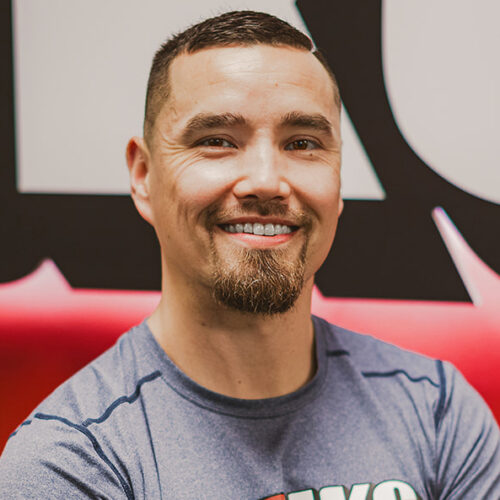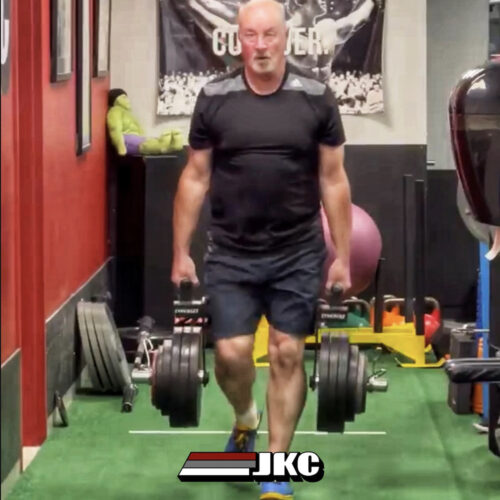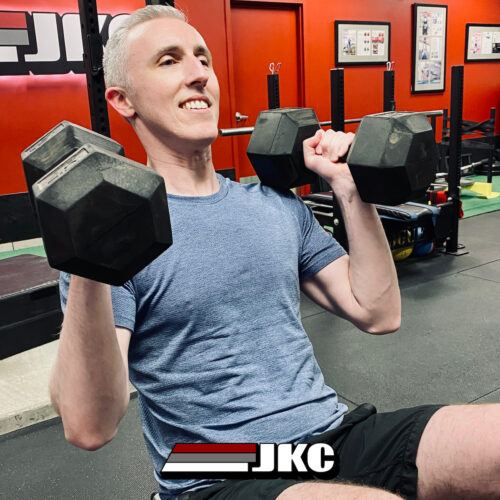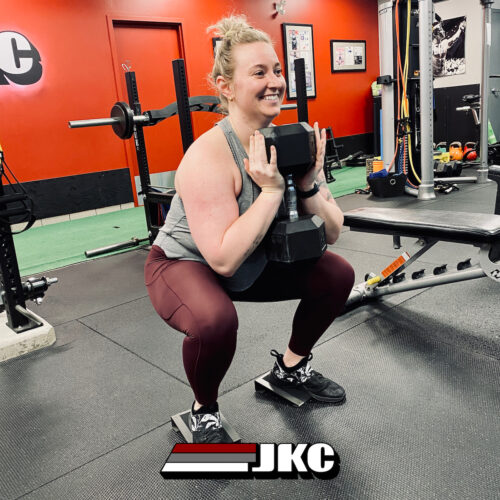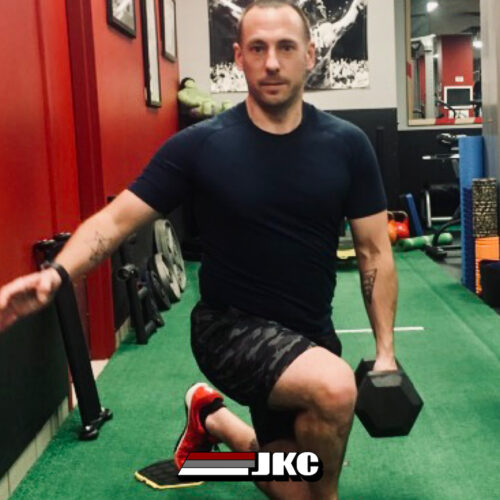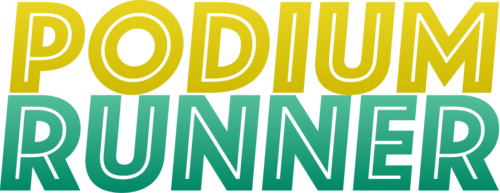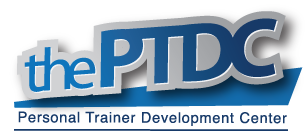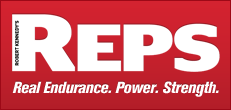Life has no boundaries…only those you make yourself.
My Dad read this out during his speech at my wedding last month.
Looking back…I think I did just that.
This is a little summary of my journey since 2005…
I’m inspired by many things in life and one of them are great strength coaches. When I graduated from school with my Kinesiology degree, I didn’t think I was going to be a strength coach or a personal trainer. I did personal training, rehab and exercise therapy during my work placements while in school, but never thought I would have a blog, enjoy it like I do and have numerous testimonials and magazine articles to show for it.
But when I got out of school, I noticed a gap, an educational to practical application gap. Simon Fraser University had a very “sciencey” Kinesiology program which was good with helping me understand anatomy and physiology, but I didn’t feel ready to treat someone with whiplash or low back pain.
I guess it is all about who you know because I got hired as a Kinesiologist in the same month that I graduated from university. My massage therapist I had for track, cross country and road running hired me after a short interview to run his clinic’s active rehabilitation and personal and athletic training program. Of course I said yes and even though I was familiar with working out and running, I wasn’t sure about the rehab side of things. I knew I had to look elsewhere for the training and knowledge to be a successful Kinesiologist and strength and conditioning coach. I wanted to stand out. I wanted to be really good at what I did – a trait I had since I was a kid.
So I started to read. I actually read more now than I did while in school! I found these awesome websites that helped me bridge this gap. T-Nation is a fantastic site that has lots of articles on various topics regarding strength and condition. I noticed I liked reading articles from a handful of strength coaches and kept going back to their individual websites often. Every spare hour I had in between clients, I was on T-nation or another strength coach’s blog, reading articles. These guys were very smart and applied science and “in the trenches” experience to their philosophy of training and to their articles. I still read these coach’s blogs today. Some include in no particular order:
- Eric Cressey
- Mike Robertson
- Mike Boyle
- Nick Tumminello
- Chad Waterbury
- Christian Thibodeau
- Jason Ferruggia
- Dan John
- Mark Rippetoe
- Pavel Tsatsouline
- Brett Jones
- Gray Cook
- Martin Rooney
- Alwin Cosgrove
- Smitty from Diesel Crew
What I’ve noticed, to become a great strength coach (which I’m not saying I am, I’m still striving for it), it helps to be well read, have a good understanding of an athlete’s and client’s mind, have a good personality, be able to communicate coaching cues to a variety of people that learn in different ways and have competed or compete in a sport of their own. My training style and philosophy is a mesh of all the people I listed above with my twist – I take all the good that I like from each coach and have created a coaching style that is unique and successful.
In addition to reading, I attended every weekend course and seminar I could on rehabilitation and strength training. One course I took in the first few months of working was on the works of Vladamir Yanda. If you haven’t heard of him, you should look him up. His work has been quoted, sited and used from all therapists alike. His newest resource called “Assessment and Treatment of Muscle Imbalance – The Janda Approach” is amazing. If you work with athletes or fitness enthusiasts, you I would highly recommend this book. One thing that I was never taught in school was how to perform a proper assessment. This book and his course make up the bulk of my assessment tests. His course teaches you how to assess posture, gait and muscle sequencing. Muscle activation patterns can be anticipated in a particular order – for example, if a athlete is lying prone and performs hip extension, we would anticipate the ipsilateral hamstring activate first, followed by the ipsilateral glutes, followed by the contralateral lumbar paraspinals and followed by the ipsilateral paraspinals. However, in a person with “gluteal amnesia” the glutes don’t fire at all or fire really late, usually after the lumbar paraspinals. This illustrates a muscle imbalance commonly seen in Lower Cross Syndrome and needs to be addressed.
I also took the initiative to become certified with one of the best known associations in the field, the National Strength and Conditioning Association with the CSCS (Certified Strength and Conditioning Specialist) designation. The text book is great and outlines everything from physiology to how to perform olympic lifts. I also become certified with the Canadian Society for Exercise Physiology as a Certified Exercise Physiologist. This provided me with the training to work with special populations and the knowledge to conduct stress tests. Earlier this year, I become Functional Movement Screen (FMS) Level 1 certified. This certification was awesome as it taught me how to differentiate the difference between mobility and stability and how to correct it. This isn’t as assessment protocol, rather a screening protocol to give insight on how well or poorly a person moves.
Again…more ways to stand out.
For those that don’t know, I also trained and got hired as a Vancouver Firefighter. I worked with the VFRS (Vancouver Fire and Rescue Services) for just over a year and a half – nothing compared to the captains and chiefs who have put in over 25 years of service. I was very honored to have worked for the city of Vancouver. I spent a lot of time working in Vancouver’s DTES (downtown east-side) on Rescue 2, a medical fire apparatus that went to all the emergency medical calls from Princess to Gastown that soon would be Medic 2. I have seen things that I thought I would have never seen and dealt with situations I couldn’t even have dreamed up. I made some great friends and enjoyed my job a lot, but I decided it wasn’t my true passion. I decided to move on from firefighting and move from my hometown of Burnaby, BC to move all the way across Canada to St. John’s, Newfoundland to pursue my Master’s Degree in Human Kinetics with David Behm – one of the more well respected researches in the field. I am very privileged to work with Dr. Behm and I’m looking forward to learning a ton.
This is my true passion and I’m really happy to be back in the field giving it 110% of my energy.
This post wouldn’t be complete without a list of tips that I have gathered and learned over the years.
I was inspired by Smitty from Diesel Crew when he came out with his 101 Tips to be EPIC.
Here’s my rendition:
- Pick up heavy stuff off the floor.
- Squat down with heavy stuff on your back, stand and repeat.
- If you can’t squat below parallel, don’t load the bar with 3 plates and say you squat over 300 lbs. That’s called a half squat.
- Improve squat mobility and groove the pattern with the Goblet Squat.
- Train your core with anti-ab exercises – “anti-movement” rather than flexing and extending the spine.
- Improve your peri-workout nutrition to get the full training effect from your workouts.
- Train hard, recover harder.
- Have a set plan of what to eat after your workout.
- Foam roll everyday.
- Do a hip flexor stretch while sitting at a desk – you can still do work in this position.
- Can’t do pushups? Then how do you expect the body to handle a barbell?
- Don’t do the empty can exercise for shoulder rehab.
- All runners should have optimal ankle mobility.
- Every person should work on hip flexor length and thoracic spine mobility.
- Stand up every 20-30 minutes while sitting.
- Do chin-tucks at every red light while driving.
- Improve your wrist extension mobility.
- Learn how to create force fast.
- Train body parts you can’t see.
- Please stop doing body part splits.
- Incorporate all planes of movement in your workout program.
- No, sit-ups suck.
- Lock your joints when you lift, they were designed to.
- It’s not always about the rotator cuff, pay attention to your Serratus Anterior too.
- Stop trying to isolate the Transverse Abdominus.
- Perform single leg work.
- Perform single arm work.
- If you sit on your butt, strengthen it.
- Learn how to hip hinge.
- Spare the spine.
- Be scared of under or over training.
- Stop changing your program every time the new Men’s Fitness hits store shelves.
- Seriously, bicep curls at the beginning of your workout?
- When deadlifting, grip the hell out of the bar.
- When bench pressing, grip the hell out of the bar.
- When squating, grip the hell out of the bar.
- Trying to improve your grip strength? Stop wearing straps.
- Get really good at glute ham raises.
- Perform single leg stiff leg deadlifts.
- Stop standing on exercise balls.
- Tuck your elbows when you do pushups.
- Strength is a skill.
- Kettlebells are not a means to an end.
- Learn to develop tension.
- Row more than you bench.
- Bench with your legs and from your lats.
- Spread the floor with your feet when you squat.
- Break the bar in half when you bench.
- Fat Grips are amazing.
- Endurance athletes need to be strong, so lift heavy with lots of breaks.
- Women shouldn’t be scared of bulking up; it’s really hard to!
- Pushups too easy? Do them one handed.
- The ab wheel is back in fashion.
- The roman chair is a great piece of equipment.
- Be strong at moving your body through space.
- Facepulls are a great shoulder exercise.
- Single leg squats on a BOSU dome up or down during rehab is great.
- Single leg squats on a BOSU dome up or down during strength training is not.
- Stop using the word core.
- Stop using the word functional.
- Sport specific training is not done in the gym, it’s done on the field.
- Endurance athletes need to worry about overuse injuries.
- Learn how to pack your scapulae.
- Stop wearing wife beaters to workout in.
- Can’t barbell snatch? Do a dumbbell or kettlebell snatch.
- Squat heavy for high reps.
- Leave your static stretches for after your workout.
- Only isolate muscles at the beginning of the workout when you are retraining a particular movement pattern e.g. glute max for hip extension.
- Nike Frees are not true minimalist shoes.
- Squat, deadlift and perform kettlebell exercises in FLAT shoes or barefeet. Chuck Taylors and Fivefingers are flat…running shoes are not.
- Conventional deadlift with a hip width apart or closer stance.
- Learn how to front squat with a clean grip.
- Chin up too easy? Load them.
- Train explosiveness with changing resistance e.g. chains or bands.
- Your back is healthier when it was more endurance.
- Stop sucking your belly button to your spine.
- There is a lot more to know about fascia. A lot…
- Don’t invest in a treadmill or elliptical you wont use; invest in a good strength coach/personal trainer.
- Endurance runners should perform explosive exercises just like sprinters.
- Don’t forget to train your feet muscles.
- Machines were created for body builders.
- Body builders train to feel the pump; athletes train to improve rate of force development.
- Shoe choice can be quite daunting; choose what’s most comfortable to your foot.
- Climb a rope…with your hands only.
- Tire flipping is cool, but not for everyone.
- Kettlebell swing with your posterior chain (glute and hamstrings); stop squat swinging.
- Build beautiful strength with the Turkish-Get Up (with a kettlebell of course).
- Stop using the adductor/abductor machine.
- Stop doing knee extensions for god’s sake.
- Beginners should learn how to move so stop putting them on a machine based program.
- Runners need to improve their recruitment of their glute meds.
- Don’t remove the stiff-elastic-storing-capability of a runner with too much yoga, you’ll make them slower.
- Abs are made in the kitchen.
- Kettlebell snatch heavy for high reps…hello conditioning.
- Side bridges killing your shoulder? Single arm farmers carry for distance.
- Do 10 overhead squats with a broomstick everyday.
- Don’t go to the gym to sit down.
- Stretch your chest and lats more.
- Roll your upper back to improve thoracic mobility every day.
- Do the sleeper stretch to stretch out the posterior capsule of your shoulder.
- Don’t have an ab wheel, do the walk out plank.
Here’s to leading a life without boundaries and always trying to improve.
Thanks so much for reading,
-JK
